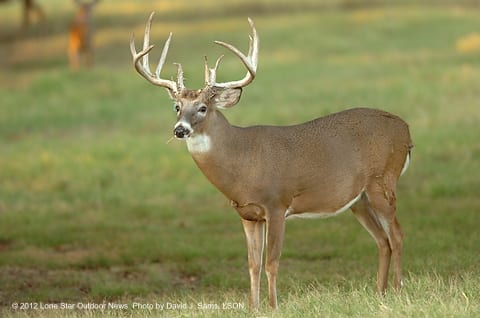 Look in any taxidermy shop, hunting lodge, or trophy room, and chances are you’ll see as many different shades of antler color as you do size of racks.
Look in any taxidermy shop, hunting lodge, or trophy room, and chances are you’ll see as many different shades of antler color as you do size of racks.
But the reason behind the color variations is not easy to pinpoint, according to Lin Poor, certified wildlife biologist for Texas Wildlife Management.
“Working all over the state, I’d definitely say vegetation has something to do with it,” Poor said. “Obviously, as bucks start coming out of velvet and start rubbing on certain species, they will start darkening somewhat.”
According to Poor, plants with thin bark that comes off easily is more likely to stain an antler, compared with a plant with thicker bark that wouldn’t lose its bark as readily.
“Mesquite does not have a thick bark, but has a hard back and is pretty vascular,” he said. “That has to rank up there with a plant that could stain a deer antler pretty easily as compared to a harder wood.”
Vegetation is not the only factor in antler color.
“There’s a genetic factor too, and all you have to do is look at a scientific breeder pen to see that,” he said. “Geographic boundaries also come into play; take a buck in South Texas and don’t let him rub out, and he is still going to be darker than a Pennsylvania deer.
“There’s definitely a genetic factor taking place, and it probably plays a heavier role than environmental factors do.”
West Texas outfitter Skipper Duncan, of San Angelo, said he sees age play a role in antler color.
“It seems like the older they are, the darker their horns get,” Duncan said. “I see lighter antlers on the young bucks, and darker antlers on older bucks.; it’s just almost a given.”
Duncan has also seen areas affected by recent fires have an impact on antler color.
“No doubt it also has to do with what kind of brush they’re rubbing on,” he said. “If they’re anywhere close to where Texas fires have been, and rub their horns on dark trees, they’re really going to have some dark horns; their horns are going to be almost black.”
Texas Parks and Wildlife Department Pineywoods District Biologist Gary Calkins also said there are a few different factors at play, and he doesn’t see a consistency throughout East Texas.
“It really varies, and you can see out of one county all kinds of variations,” he said. “I noticed last year we had a lot of fires, and the antlers were real dark, almost black, which I put off to rubbing on burnt trees.”
This isn’t to say the genetics and age don’t have a part.
“I really do feel like it’s just a difference in genetic variability, but also what they’re rubbing on,” he said. “Most younger animals are usually a little lighter, and by three and a half tend to get a little darker.”

